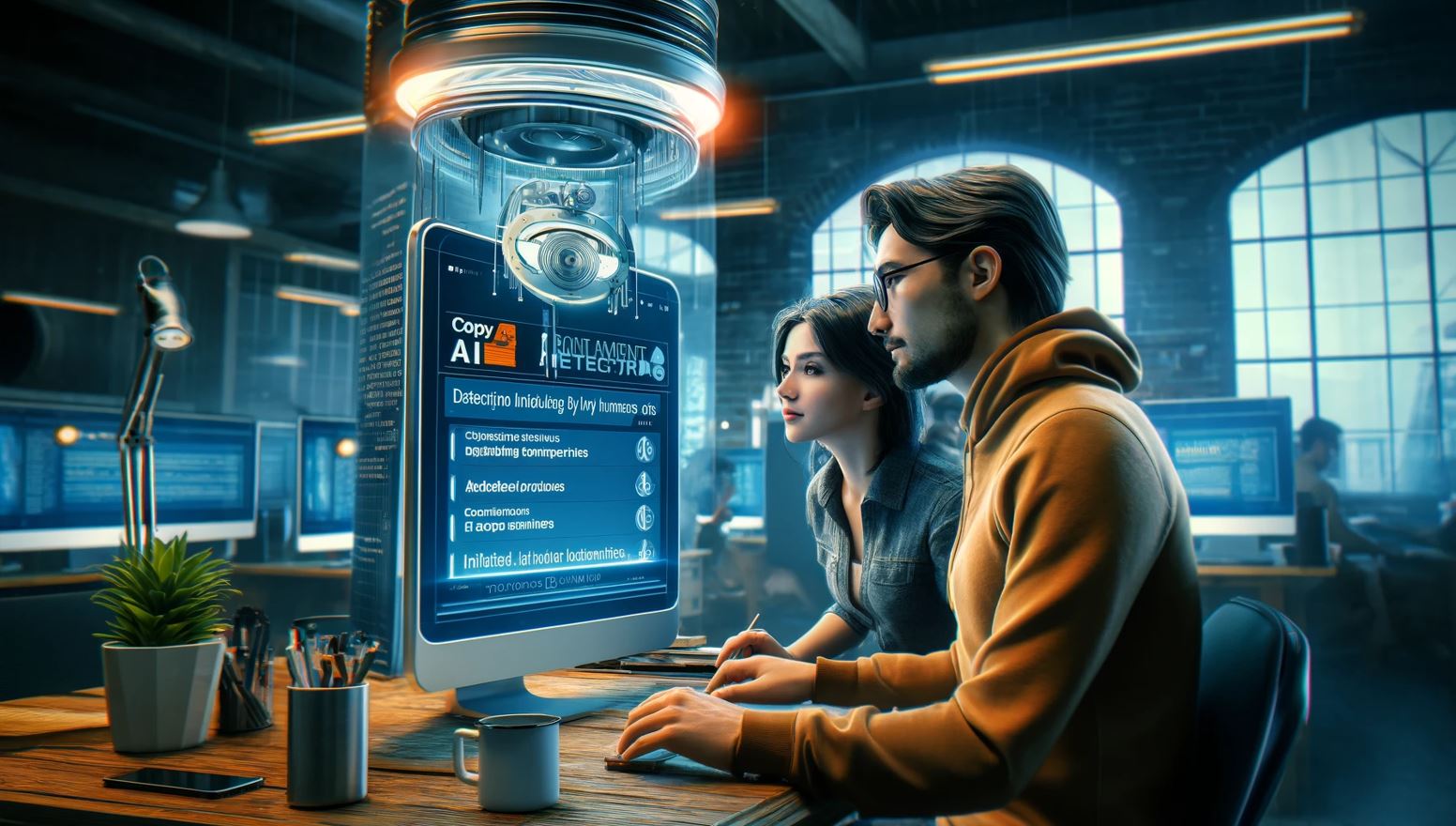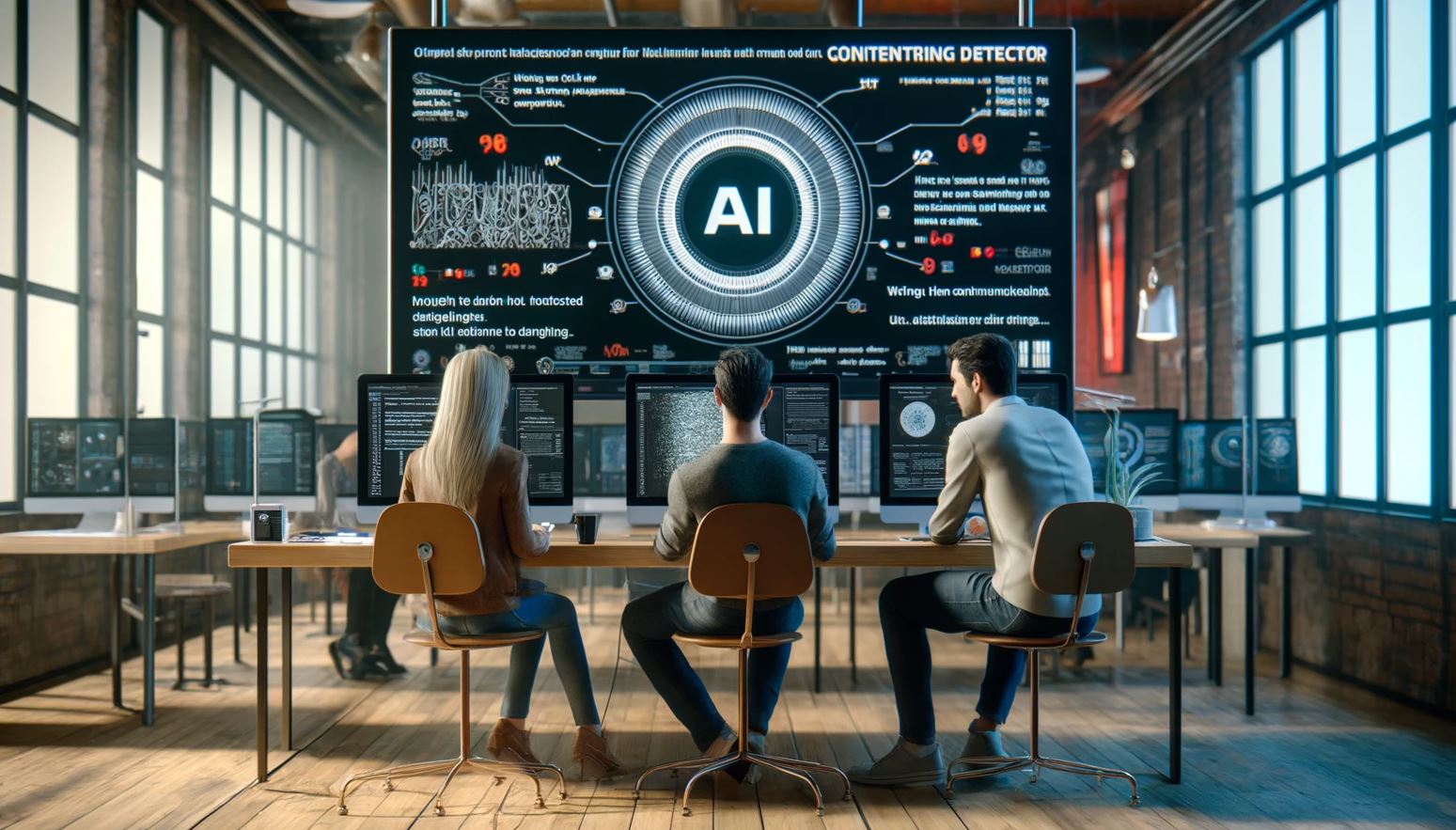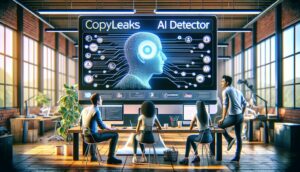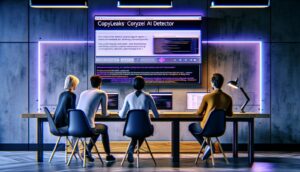How accurate Is Copyleaks AI detector? Can it really sniff out AI-generated writing? Read on to find out.
Ever wondered if that article you read online was penned by a human or a crafty AI? You’re not alone. With AI-written content flooding our screens, telling the difference has become crucial yet tricky for many of us.
Good news – there’s tech out there trying to make this Herculean task easier, like Copyleaks AI Detector.

Try these new AI-powered tools:
- 5 Best AI Detectors To Unmask AI-Written Content With Accuracy
- 5 Best AI Writers To Boost Your Productivity And Content Quality.
- This "Secret AI Writer" Can Bypass AI Detection Like A Pro.
A standout fact in this digital detective story – a study found Copyleaks to be incredibly sharp, with an accuracy rate soaring above 98%. Impressive, right?
This blog will walk you through how Copyleaks manages to do what it does and why its laser-focused accuracy is something to chat about over dinner.
Expect comparisons with other tools and some eye-opening realities on what goes wrong when AI detection gets it wrong. Ready for an enlightening read?
Article At-A-Glance
- Copyleaks AI Detector is very accurate, with a study showing it can find AI-written content 99.1% of the time. It hardly ever makes mistakes.
- This tool checks texts by looking for clues that show if they are from humans or machines. It uses smart ways to figure this out and works well for many types of writing.
- Compared to other tools, Copyleaks comes out on top because it doesn’t just look at the words but also how the ideas in a text fit together.
- If we don’t catch fake writing well, there could be big problems like losing trust or legal issues. Copyleaks helps avoid these troubles by finding copied work very well.
- For those needing help in 2024, tools like Copyleaks and others mentioned will be key in making sure writings are unique and not stolen or made by robots.
Table Of Contents
How Accurate Is Copyleaks AI Detector?
So, you’re curious about Copyleaks AI Detector’s accuracy, huh? Well, let me spill the beans: imagine hitting the bullseye in a game of darts.
Study Confirms Copyleaks As Most Accurate AI-Generated Text Detector
Recently, a study made big news for showing Copyleaks as the top dog in sniffing out AI-generated text. This wasn’t just any pat on the back—four different third-party studies gave it a thumbs-up for being spot-on accurate.
Imagine that! While other tools might miss the mark, Copyleaks is like a detective with a magnifying glass, catching even the sneakiest AI-written words.
This cool tool mixes smart human thinking with machine smarts to check content like no other. Whether you’re dealing with essays, reports, or articles, Copyleaks has got your back.
This cool tool mixes smart human thinking with machine smarts to check content like no other. Whether you’re dealing with essays, reports, or articles, Copyleaks has got your back.
It turns out that all those claims about its accuracy aren’t just hot air. They’ve really proven themselves. With all sorts of ways to put content under its microscope, it’s no wonder why folks are saying it’s reliable and efficient at finding AI fingerprints on texts.
How The Detection Process Works
Moving from recognizing Copyleaks as a top performer in AI-generated text detection, let’s explore how its sophisticated system checks for originality and identifies whether the content is human or AI-made.
The process begins with the tool scanning texts to find similarities and differences compared to other works. It looks at word patterns, writing styles, and unique phrases.
This isn’t just about finding copied sentences but understanding if a piece of content feels more like it came from a machine than a person.
Copyleaks uses advanced algorithms to evaluate the authenticity of documents. These algorithms are smart enough to pick up on the subtle hints that might indicate artificial intelligence had a hand in creating the text.
They consider factors such as sentence structure, complexity, and even how ideas flow within paragraphs.
With an accuracy rate of up to 99.12%, this platform gives users confidence by integrating seamlessly into Learning Management Systems (LMS), making it easier for teachers and businesses alike to ensure the integrity of written work without sweating over intricate details themselves.
Results Of The Study
The study showed that Copyleaks is super good at finding AI-written stuff, with a whopping 99.1% accuracy rate. This means it rarely messes up, catching almost all fake content without getting confused by the real deal.
Plus, it’s got this tiny false positive rate of just 0.2%, which is basically the best score you could hope for in a game where detecting fakes is key.
Now, with such high marks in detection and barely any mistakes to its name, Copyleaks proves it’s not just another tool in the shed—it’s more like the sharpest knife in the drawer when cutting through AI-generated fluff.
Here come comparisons with other tools.
Copyleaks AI Detector Vs Other Detection Tools
So, you’re wondering how Copyleaks stacks up against other AI detection tools? Well, let me tell you—it’s kind of like comparing a superhero to the rest of us mere mortals.
Studies are showing that when others zig, Copyleaks zags right into the lead with its spot-on accuracy.
Comparison Of Copyleaks With Other AI Detection Tools
Comparing Copyleaks to its competitors really puts things into perspective. Imagine being at the Olympics of AI detection tools, where each contender has trained, optimized, and honed its algorithm to detect AI-generated content with the precision of a hawk spotting its prey from miles away.
Copyleaks, in this metaphorical scenario, is the athlete who not only finishes the race first but also does it with style, showcasing a 99.12% accuracy rate that leaves the crowd (and its competitors) in awe.
This table breaks down how Copyleaks stacks up against other major players in the field:
| Tool | Accuracy Rate | Unique Features | Overall Performance |
|---|---|---|---|
| Copyleaks | 99.12% | Deep search technology, extensive database access | Top-notch, reliable |
| OpenAI | 95% | Innovative AI models | Impressive, but lacks the depth of Copyleaks |
| Writer | 93.5% | User-friendly interface | Good, but more suited for casual checks |
| GPTZero | 91% | Specializes in educational content | Decent, but niche-focused |
| CrossPlag | 94% | Cross-referencing capabilities | Strong, yet not as versatile as Copyleaks |
Sure, numbers do tell a story, but it’s the nuanced details, like Copyleaks’ unrivaled depth of search and database access, that really highlight why it stands out from the pack.
Other tools, while competent in their own right, seem to play catch-up in areas where Copyleaks effortlessly shines. It’s almost like comparing a Swiss Army knife to a standard screwdriver—both useful, but one clearly brings a lot more to the table.
Copyleaks not just cruises by on its accuracy but also brings an arsenal of features that cater to a wide variety of needs, from academic integrity to legal and content creation fields.
The other contenders, despite their strengths and unique angles, ultimately find themselves a step behind in this race towards unparalleled precision and utility.
Third-Party Studies Confirming Copyleaks’ Accuracy
Four independent studies took a good look at Copyleaks and what they found was pretty cool. Turns out, Copyleaks is the top dog for catching AI-written text. Yep, you read that right.
With a knockout accuracy of 83%, it beat out all the other tools in the ring. This wasn’t just any study either—it was done by folks who know their stuff, making it a big deal in the content detection world.
These third-party validations showed something many had guessed but now could prove: Copyleaks really knows how to spot AI’s sneaky work better than others. It wasn’t just about throwing punches since they checked every detail, leaving no stone unturned to ensure they got it right.
And boy, did they deliver! Trust me, having these outside experts give their thumbs up means you’re not just taking someone’s word for it—you’ve got cold-hard facts backing up those claims of top-notch accuracy and efficiency.
Potential Consequences Of Inaccurate AI Detection
Getting AI detection wrong can lead to a big mess. Think less trust from clients, money down the drain, and a tough time staying ahead in the game.

Damage To Brand Reputation
Having a brand caught using plagiarized or wrong content can really hurt its image. People respect brands that offer original, trusty stuff.
If they find out a brand’s been sharing copied or false info, bye-bye, credibility! It shows the world they might not care much about authenticity.
Worse still, it could look like they’re okay taking someone else’s hard work as their own. That’s a no-go in anyone’s book.
So, imagine the fallout if inaccurate AI detection lets plagiarized work slip through the cracks. Suddenly, you’ve got unintentional plagiarism on your hands—ouch for the brand integrity!
No one wants to be seen as lazy or deceptive, right? And sure enough, this leads us straight into pondering legal risks—a whole other headache you don’t want.
Legal Risks
Mistakes in AI detection can lead to big trouble over copyright or plagiarism. Imagine getting accused of using someone’s work without okay.
That’s not just embarrassing. It’s a legal mess! With Copyleaks, reducing these slip-ups means fewer headaches about lawsuits or bad marks on your report card.
Copyleaks’ knack for spotting what’s real and what’s AI-made could save you from court dates and losing cash.
Say someone wrongly claims you cheated with AI. The right tools could clear your name fast, dodging nasty penalties and keeping your rep shiny.
Decreased Content Quality
Bad AI detection can lead to low-quality content. This means blogs and articles might not be as good because mistakes slip through. If a tool cannot tell if writing is from a robot or a person, errors are more likely.
People expect solid and clear information. If they get poor writing instead, they won’t trust or like the content.
Using unreliable tools for spotting AI-written text also leads to bad quality. When these tools mess up, it’s easy for wrong or unclear info to appear in what we read online. Quality drops because no one catches these slips before readers see them.
So, picking a great tool matters if we want everyone to enjoy reading something worthwhile and accurate.
Wasted Resources
Faulty AI detectors can cause big problems, like pointing fingers at the wrong pieces of work. Imagine a student’s project getting flagged as not original when it really is, or a writer accused of copying.
This mix-up eats up time and effort to set straight. It also puts stress on trust between teachers, students, and content creators.
These mistakes have real costs. Schools might spend extra money checking work again or dealing with unhappy people wrongly accused. Writers could lose jobs or face legal trouble over false claims they stole words.
All because the tool didn’t catch the right cues.
Loss Of Competitive Edge
Brands and agencies risk falling behind if they miss content misuse by competitors because of inaccurate AI detection.
This can mess up their place in the market. Imagine working hard to stand out, only to let others copy your ideas without spotting them.
That could really put you at a disadvantage.
Also, getting it wrong with AI-generated content might lead to false charges. Think about the damage from being wrongly accused of using AI for tasks or homework. It’s not just about hurt feelings—there are real penalties and legal headaches too.
So, staying ahead means making sure your AI detector spots every trick in the book, keeping your reputation shiny and clean.
Impact On Operational Efficiency And Client Trust
Mistakes in finding AI-made texts can slow down work and make clients doubt us. If tools like Copyleaks don’t catch when content is made by AI, teams waste time checking again. This can make things slow and costly.
Clients may start to worry if what they get has the quality they need.
Trust comes from knowing the work is good and real, not made by a machine. When AI text detectors mess up, it’s hard for customers to feel sure about what they get. They might think twice before trusting us again.
It’s all about being reliable – no one wants their name tied to fake or low-quality stuff.
Financial Costs
Talking about how things can go wrong fast, let’s shift gears to the money talk. If you thought dealing with trust issues was a headache, imagine getting hit where it hurts most—your wallet.
AI detection tools messing up can lead to false AI cheating accusations. Picture being accused unfairly. Now, you’re not just fighting for your reputation but also opening up your piggy bank to set the record straight.
You might need to hire experts or lawyers to prove you did nothing wrong. This is where big bucks start flying out of your pocket without warning.
And if you’re in the business of creating content, think about the cost of finding those ace writers to avoid copyright troubles down the line.
And if you’re in the business of creating content, think about the cost of finding those ace writers to avoid copyright troubles down the line.
It’s pretty clear—a simple mistake in detecting AI-generated content could end up costing more than just a few dollars and some hurt feelings.
Need For Continuous Vigilance
Keeping our eyes open and staying alert is a must now more than ever. With AI getting better at creating content, tools for spotting this AI-generated stuff need to get sharper too.
We’ve seen that these detectors aren’t perfect—they miss some fakes and call out real stuff as fake by mistake. So, we have to keep testing and improving these tools. It’s kind of like playing catch-up with technology.
The stakes are high because messing up could lead to serious problems—like hurting your brand’s good name or even facing legal trouble. Plus, nobody wants their hard work wasted or to lose the trust of clients over something avoidable.
That means always being on the lookout and ready to enhance accuracy with every chance we get. It’s all about not letting our guard down because the moment we do, those mistakes can sneak right through.
Copyleaks AI Detector Boasts Accuracy For Content Detection And Protection
Copyleaks AI detector shines as a top choice, with studies showing its accuracy. It beats many other tools in detecting AI-written content. This tool helps avoid trouble, like legal issues or losing trust.
For anyone worried about quality and reliability, Copyleaks is a smart pick. Trust me, it’s worth checking out for keeping your content game strong.
FAQs
1. Is Copyleaks AI detector really good at finding copied stuff?
Oh, you bet it is—it’s kind of like having a super-smart detective on your team.
2. Can it miss some sneaky copies sometimes?
Sure, even the best detectives get tricked once in a while, but it’s rare.
3. Will it catch me if I just change a few words here and there?
Yep, changing a few words won’t fool this clever tool—it sees right through that game.
4. How fast does this AI give me the results?
Quick as lightning! Well, almost—you won’t be waiting long to see what it finds.
5. Does using Copyleaks AI make my work completely safe from plagiarism accusations?
It gives you a solid shield, but remember, staying original is your best armor against plagiarism woes!
Meet our resident tech wizard, Steve the AI Guy. Now, before you get any wild ideas, let’s clear up one thing – he’s 100% human! I mean, he’s got the work history to prove it. He spent a decade diving into the deep end of the tech industry doing business intelligence work, splashing around with two of the world’s largest business consulting companies, Deloitte and Ernst & Young. Learn More










